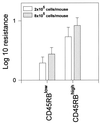CD4(+) T-cell subsets that mediate immunological memory to Mycobacterium tuberculosis infection in mice
- PMID: 10639425
- PMCID: PMC97184
- DOI: 10.1128/IAI.68.2.621-629.2000
CD4(+) T-cell subsets that mediate immunological memory to Mycobacterium tuberculosis infection in mice
Abstract
We have studied CD4(+) T cells that mediate immunological memory to an intravenous infection with Mycobacterium tuberculosis. The studies were conducted with a mouse model of memory immunity in which mice are rendered immune by a primary infection followed by antibiotic treatment and rest. Shortly after reinfection, tuberculosis-specific memory cells were recruited from the recirculating pool, leading to rapidly increasing precursor frequencies in the liver and a simultaneous decrease in the blood. A small subset of the infiltrating T cells was rapidly activated (<20 h) and expressed high levels of intracellular gamma interferon and the T-cell activation markers CD69 and CD25. These memory effector T cells expressed intermediate levels of CD45RB and were heterogeneous with regard to the L-selectin and CD44 markers. By adoptive transfer into nude mice, the highest level of resistance to a challenge with M. tuberculosis was mediated by CD45RB(high), L-selectin(high), CD44(low) cells. Taken together, these two lines of evidence support an important role for memory cells which have reverted to a naive phenotype in the long-term protection against M. tuberculosis.
Figures








References
-
- Akbar A N, Terry L, Timms A, Beverley P C, Janossy G. Loss of CD45R and gain of UCHL1 reactivity is a feature of primed T cells. J Immunol. 1988;140:2171–2178. - PubMed
-
- Andersen P, Andersen A B, Sorensen A L, Nagai S. Recall of long-lived immunity to Mycobacterium tuberculosis infection in mice. J Immunol. 1995;154:3359–3372. - PubMed
Publication types
MeSH terms
Substances
LinkOut - more resources
Full Text Sources
Medical
Research Materials
Miscellaneous

